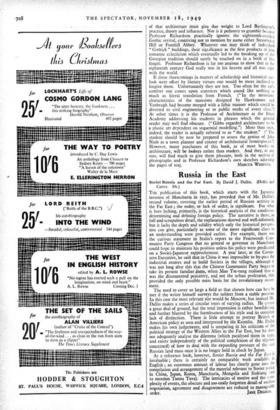Russia in the East
Soviet Russia and the Far East. By David J. Dallin. (Hollis and Carter. 30s.)
THE publication of this book, which starts with the Japancs: invasion of Manchuria in 1931, has preceded that of Mr. Dallin's second volume, covering the earlier period of Russian activity in the Far East ; the order, or lack of order, is significant. For what is here lacking, primarily, is the historical analysis of the conditions determining and defining foreign policy. The narrative is there, in full and scrupulous detail, the explanations shrewd and well-informed, but it lacks the depth and solidity which only the historical perspec- tive can give, particularly as some of the more significant clues to an understanding were provided earlier. For example, there wet the curious statement in Stalin's report to the Fourteenth Com- munist Party Congress that no general or governor in Manchuru could hope to maintain his position unless his policy were predicated on a Soviet-Japanese rapprochement. A year later, at the Comin- tern Executive, he said that in China it was impossible to by-pass the industrial centres and to build Soviets in the villages, although it was nor long after this that the Chinese Communist Party began to take its present familiar Jams, when Mao Tse-tung realised that it was the discontented peasantry, and not the urban proletariat, that provided the only possible mass basis for the revolutionary move- ment.
The need to cover so large a field as that chosen here can best be met if the writer himself surveys the subject from a stable position. In this case the most relevant site would be Moscow, but instead Mr. Dallin makes a series of circular tours of varying radius. He covers a great deal of ground, but the total impression is rather bewildering, and further blurred by the formlessness of his style and its complete lack of distinction. There is little attempt to portray British or American policy as seen and interpreted by tffe Kremlin. Mr. Dallin makes his own judgements, and is unsparing in his criticism of the political strategy of the Western Allies in the Far East, but he does not adequately analyse the dilemma (which paralysed them in 1931, and exists. independently of the political complexion of the regimes concerned) of how to deal with the expanding pressure of the vast Russian land mass once it is no longer held in check by Japan. As a reference book, however, Soviet Russia and the Far East is invaluable ; there is certainly no comparable work available in English ; an enormous amount of labour has clearly gone into the compilation and arrangement of the material relevant to Soviet poked In China, Japan, Korea, Manchuria, Mongolia and Sinkiang (not to mention Tannu Tuva). The intricacies of motive and the com- plexity of events, the obscure and too easily forgotten detail of ethilcsi negotiation, agreement and disagreement are reduced to managed














































































 Previous page
Previous page